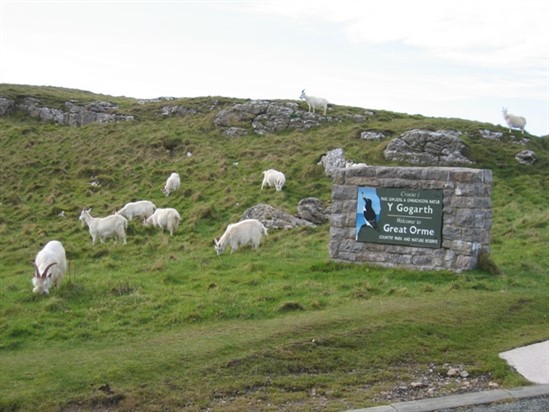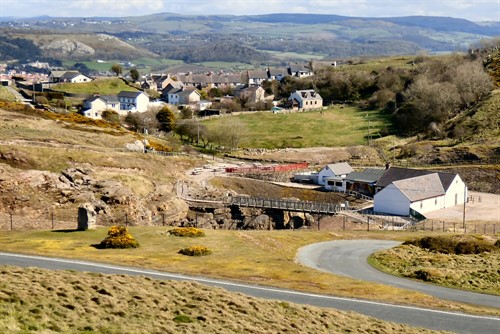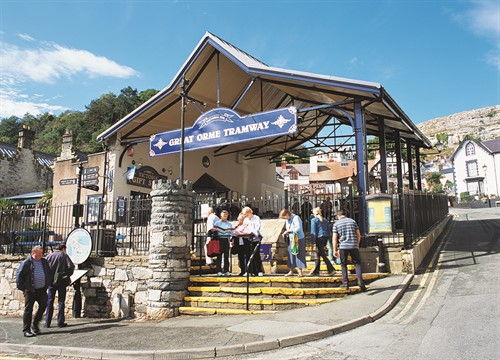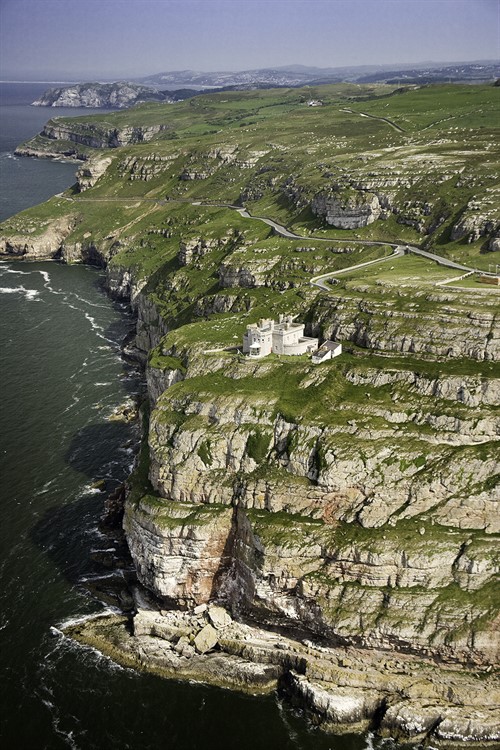Posted on 30/08/2017 by David
As you drive into Llandudno, whether you come from the busy and bustling North Shore, or the quieter West Shore, you’ll see it. You can’t miss it, rising a rather impressive 207 metres out of the sea, dwarfing the Pier. Yes - we are talking about the Great Orme.
This huge chunk of limestone is one of Llandudno’s most iconic features. Travel up by foot, car, tram or cable car and admire the sweeping views of the seaside town known as ‘the Queen of Welsh Resorts’ and the Irish Sea - on a really clear day, as far as Liverpool.
But it’s far more than a big rock with pretty views. With a history dating back more than 350 million years, it's home to all sorts of rare flora, fauna and wildlife. And as a designated country park, there’s plenty of things to do here that don’t cost a fortune.
Granted, it’s a very popular tourist hotspot but how well do you actually know the Great Orme? In this week’s blog, we’ve put together 10 facts about Llandudno's 'mini mountain' that will give you a new appreciation of this incredible North Wales landmark.
1. What's in a name?
The name Great Orme didn't come into common usage until the nineteenth century, when the headland was developed as part of the seaside resort of Llandudno. Prior to that it was known by several Welsh names including Creuddyn (old Welsh) and Pen y Gogarth (after the medieval bishop's palace on the West Shore).
Originally, however, it is thought that the name came from the Norse for sea serpent or 'Urm' - sailors approaching the headland described its shape as like a huge serpent rising from the sea!
2. The Orme is home to an unusual species of goat
The Orme is home to a herd of around 180 wild Kashmiri goats, from a breeding pair gifted by the Shah of Persia (now Iran) to Queen Victoria on the occasion of her coronation in 1837.
If they were good enough for a queen... naturally, the goats became very fashionable! The Mostyn family (influential landowners in the Llandudno area) acquired a pair from the queen's herd but, when they were found to be unsuited to the genteel surroundings of nearby Gloddaeth Hall, they were released into the harsh environment of the Great Orme, where they thrived.
These beautiful creatures are a familiar sight to all who live and visit on the Great Orme today. Keep in mind they are wild animals and should be treated with courtesy, even when they cause havoc in residents' back gardens!
Since Queen Victoria's reign the Royal Welsh Fusiliers have selected their regimental mascot from the Great Orme herd. Currently, William 'Billy' Windsor II serves the regiment, having been specially selected for his post in 2009.

3. It has the largest prehistoric copper mine in the world
First worked during the Bronze age, around 4,000 years ago, the Great Orme was found to hold rich deposits of copper - then used for everything from ceremonial jewellery to weapons.
This rich seam was mined for around 1,000 years, during which time more than five miles of tight tunnels and passages were excavated (some of the tunnels are so small they could only have been dug out by children). Mining ceased in the late 1800's and, although the mine's presence was commonly acknowledged, a detailed analysis of the site did not commence until the 1980s.
Since then archaeologists have spent years investigating the site, finding more than 30,000 bones - human and animal - and other fascinating tools and artefacts. In 2005, it entered the record books as the largest prehistoric copper mine in the world. Today, the mines are open to the public and are one of the biggest tourist attractions in the area.

4. Ride the only cable-hauled tramway in Britain
The Great Orme Tramway is the only cable-hauled public road tramway in Britain, climbing a mile from its base station on Church Walks to the Summit Complex.
Opened in 1902, this timeless tourist attraction originally served the residents and businesses of the Great Orme, hauling passengers, goods and supplies up and down its steep slopes. It quickly gained popularity with genteel visitors not keen on hiking the trail to the summit, and its appeal endures to this day.

5. A secret cave with a mysterious history
Although the Great Orme is home to many caves and caverns, only those with Kashmiri goat-like scrambling abilities can reach this intriguing little chamber on the western slopes of the Orme, making it something of an enigma.
Truth be told, it's easier to reach Ogof Llech (the Hiding Cave) from the sea than by land. Little is known about the cave, believed to have been St Tudno’s cell in the 7th century. Tudno is the patron saint of Llandudno so it is quite possible he sought solitude here.
What's more interesting are the alterations made at a later date - the mysterious angel statue at the mouth of the cave and the dressed sandstone walls within. Some have linked the cave with the Knights Hospitaller, warrior monks of the Crusader period, and claim it was a chapel used by the knights when travelling from their base at Ysbyty Ifan to the Holy Land.
Others venture the cave was remodelled by the Mostyn family in the Tudor period, having linked the sandstone to a Mostyn-owned quarry in Talacre up the coast. During the First World War, three escaped German officers hid in the cave awaiting rescue from a German submarine but were later captured in Llandudno, having missed their rendezvous!
We have tried to reach the cave on foot but the going was far too steep - unless you are experienced and have the right equipment, please don't try this yourself!
6. Little and large
The Orme isn’t the only headland with aspirations of greatness rising from the waters around Llandudno. Its little brother, called - you guessed it - the Little Orme, is located at the far side of the bay, reaching just short of 150 metres at the summit.
The Little Orme has a fascinating history of its own but was never developed in the same way as the Great Orme. It's a picturesque and tranquil spot, great for a ramble and beloved by twitchers who flock to see the vast array of seabirds that make their home on the Little Orme's sheer - and safe - cliffs.
7. The Great Orme has its very own rally stage
The cliff-hugging road that winds its way around the Great Orme, called the Marine Drive, is a scenic drive that tourists flock to enjoy all year round. However, this snaking road is regularly used as a stage in several major rally competitions, including the Cambrian Rally. At just under 3 miles long, the current record for completing it stands at 2 minutes, 37 seconds.
The Marine Drive must be driven to be believed! Extremely 'twisty and turny', with a sheer drop to the sea below and towering cliffs above, we recommend you take a lap next time you visit to fully appreciate how brave (or foolish) those rally drivers are - albeit at a more sedate pace!
8. Lost at sea
In the waters surrounding Llandudno and the Great Orme there have been more than thirty shipwrecks over the last couple of centuries. Despite the presence of an impressive lighthouse poised at the Orme's northernmost tip, many ships have met their end dashed on the rocks at the foot of the mountain.
One example is the Hornby which was wrecked against the Orme on New Year’s Day 1824. The trans-Atlantic ship was heading to South America from Liverpool but never made it. All passengers and crew, bar one man, were killed in the disaster. The survivor, John Williams, climbed to safety and spent the rest of his life living and working as a miner on the Great Orme.
9. Fancy staying in a lighthouse?
One of the most photographed landmarks on the Great Orme is the lighthouse. This crenellated building, more like a castle than a traditional lighthouse, perches precariously at the most northerly point of the headland looking out over the Irish Sea.
For more than 100 years the lighthouse provided a safe conduct for sailors crossing the Conwy Estuary and Llandudno Bay but it was decommissioned in 1985. It’s now a luxury bed and breakfast, billed as one of the most unusual places to stay in the UK; you can still see the original lantern and optics on display at The Summit Complex visitor centre.

10. The Orme has really rare - and ancient - flora and fauna
Untouched for thousands of years, the Great Orme of today hasn't changed all that much since prehistory. In fact, many of the flowers that grow on the Orme evolved following the last Ice Age. Thankfully, it’s not quite as cold up here these days, but these hardy little flowers have retained their alpine character.
The heathland of the Orme consists of shallow, lime rich soil, which is perfect for wild flowers such as poppies and orchids. But - rarest of all - is the cotoneaster Cambricus, a variety unique to the Great Orme and which survives in just six plants (caged for safety from those ravenous goats!).
It’s also home to rare species of butterfly, a pretty little thing called the Silver Studded Blue, and if you keep an eye on the sea you might be lucky enough to spot the local grey seals, a school of bottlenose dolphins or a basking shark!
If these facts have inspired you to explore the Great Orme and, trust us, these facts are just the tip of the iceberg, why not check out our holiday cottages in Llanduno?
Images courtesy: Great Orme Goats, John S Turner via Wikimedia Commons. Copper Mine, © Copyright Gerald England and licensed for reuse under this Creative Commons Licence.

